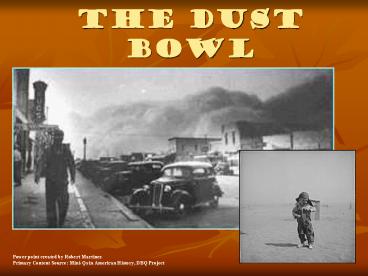The Dust Bowl - PowerPoint PPT Presentation
Title:
The Dust Bowl
Description:
The Dust Bowl Power point created by Robert Martinez Primary Content Source: Mini-Qs in American History, DBQ Project The Dust Bowl Many more, stayed put, covering ... – PowerPoint PPT presentation
Number of Views:467
Avg rating:3.0/5.0
Title: The Dust Bowl
1
The Dust Bowl
Power point created by Robert Martinez Primary
Content Source Mini-Qs in American History, DBQ
Project
2
(No Transcript)
3
- On Thursday, April 18,1935, a huge, black,
billowing cloud of dirt piled up on the western
horizon.
4
- For Stratford, Texas, and thousands of farms and
small towns, it was the arrival of another dust
storm, one of more than 300 that would make an
unwelcome visit to the Southern Great Plains
during the 1930s.
5
- For thousands of years the Southern Plains were
covered by prairie grass and home to vast herds
of twenty or thirty million buffalo.
6
- In more recent times, people arrived. First came
the Apache, the Comanche, and the Kiowa.
7
(No Transcript)
8
- Shortly after the Civil War, there came a few
thousand cowboys and several million cattle.
9
- The first farmers arrive in the 1880s. Word had
gotten out back East that the Southern Great
Plains was good for growing wheat.
10
- Yes, rainfall was a bit spotty, but the land was
cheaper than farmland in Arkansas or Illinois.
11
- With few trees for lumber, many of these early
farmers lived in soddies, houses made of earth
and grass.
12
- Soddies houses made by cutting out bricks of
prairie sod and stacking them to make walls.
13
- A severe drought in the 1890s caused some farmers
to move away, but then the federal government
created new incentives to homestead.
14
- A new Enlarged Homestead Act passed in 1909
offered 320 acres of land to anyone who could
hang on for three years.
15
- Thousands of new farm families took up the offer.
Wheat would replace cattle as the new king of the
Southern Plains.
16
(No Transcript)
17
(No Transcript)
18
(No Transcript)
19
- The railroad sent out branch lines to small
towns, and more wheat could get to market.
20
(No Transcript)
21
- World War I, which brought so much pain to
Europe, was good for Plains farmers. A
war-ravaged Europe purchased Kansas wheat.
22
(No Transcript)
23
- With the demand so high, wheat that sold for 93
cents a bushel in 1914 was close to 2.50 in
1919. Even more farmers moved to the area.
24
(No Transcript)
25
- But then trouble came. The Great Depression of
the 1930s was only the beginning of troubles in
the region.
26
- Unemployment back East made it harder to sell
wheat. Sadly, the Great Depression did not come
alone.
27
- What made life on the Southern Plains almost
unbearable were the dust storms.
28
- Decades of poor land-management, crop-rotations,
poor irrigation, fertilization and periods of
drought left the top soil dry and barren leaving
the soils to the winds.
29
(No Transcript)
30
- In the middle thirties these wind-driven dusters
darkened the midday sky and carried off millions
of tons of precious topsoil as far as Washington
D.C. and New York City.
31
(No Transcript)
32
- During the 1930s more than three million plains
settlers left their farms, some for town, some
for a neighboring state, some for California.
33
(No Transcript)
34
(No Transcript)
35
(No Transcript)
36
- Many more, stayed put, covering their windows
with a water-soaked sheet, eating jackrabbit stew
at a kitchen table where an eating cloth
covered all the plates and drinking cups.
37
(No Transcript)
38
(No Transcript)
39
- Children died from breathing in dust. They call
it dust pneumonia.































